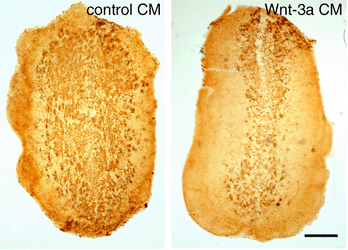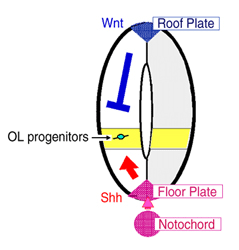中枢神経系のミエリン形成細胞であるオリゴデンドロサイトは、神経管腹側の限局した神経上皮細胞から発生することが知られている。池中研究室では、この神経管腹側に限局したオリゴデンドロサイトの発生を制御する分子機構の一つとして、神経管背側からオリゴデンドロサイトの発生と分化を抑制する未知の分泌性シグナルが産生されていることを報告した。今回新たに、この背側抑制活性の経時変化を調べ、活性変化と相関した発現パターンを示す遺伝子を検索しWntに着目した。Wntは体軸形成、器官形成など、胎仔期の発生現象を多岐に渡って制御することが知られていたが、中枢神経系の各細胞系譜の細胞分化運命決定に関するWnt の機能については当時報告がなかった。そこで、マウス胎仔脊髄の組織片培養と分散培養を用いて、Wnt-3a上清添加実験やレトロウイルスベクターを用いたWntカノニカル経路の異所的活性化などのgain of function、及びWntノックアウトマウスの解析やWntアンタゴニストの添加実験などloss of functionの解析を行い、神経管背側に発現しているWntがオリゴデンドロサイトの発生を抑制することを明らかにした。これらの結果から、神経管におけるオリゴデンドロサイトの発生は、神経管腹側から産生される分泌性因子Sonic hedgehog (Shh)と、背側から産生されるWntの両因子によって厳密に制御される機構が示唆された。今後、本研究成果に基づいた脱髄性疾患治療へのWntシグナル因子の応用が期待される。
Takeshi Shimizu, Tetsushi Kagawa, Tamaki Wada, Yuko Muroyama , Shinji Takada and Kazuhiro Ikenaka: Wnt Signaling Controls the Timing of Oligodendrocyte Development in the Spinal Cord. Developmental Biology, 282(2): 397-410, 2005

Decrease in the number of O4+ oligodendrocytes in the VM fragment by the Wnt-3a supernatant. Many O4+ oligodendrocytes were observed in the VM fragment cultured with the control conditioned media of L cells that expressed the neo resistant gene (control CM). Reduction of the O4+ oligodendrocyte number was observed especially in the peripheral region by the addition of the conditioned media from L cells that expressed Wnt-3a cDNA (Wnt-3a CM).

Schematic summary of Wnt action on oligodendrocyte development. Oligodendrocyte progenitors are generated from a restricted region of the ventral ventricular zone in the spinal cord. These events are controlled by graded inductive and repressive signals derived from a local organizing center. Sonic hedgehog (Shh) was identified as an essential ventral factor for oligodendrocyte lineage specification. In this study, Wnts were identified as repressive signals for oligodendrocyte maturation derived from dorsal region of the spinal cord.